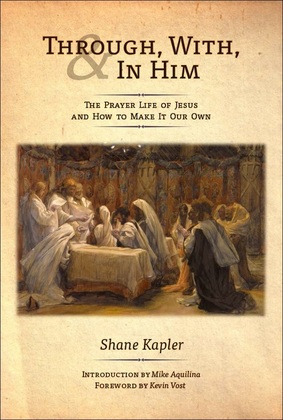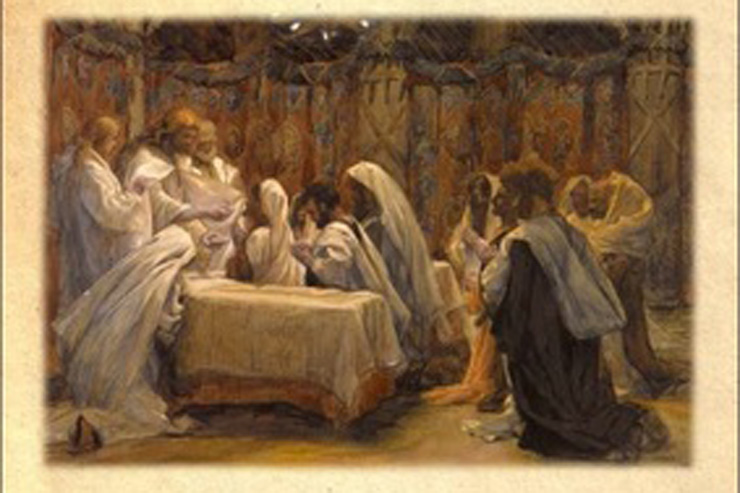 Although I don’t do it as often as I would like, occasionally I get to interview my fellow Catholic authors and talk about some of the excellent books being produced today. I have known one such author named Shane Kapler for a few years and was thrilled when he asked me to write about his excellent new book, Through, With, and In Him: The Prayer Life of Jesus and How to Make It Our Own. This is a book for everyone and I encourage you to get a copy for yourself (and friends) as soon as possible.
Although I don’t do it as often as I would like, occasionally I get to interview my fellow Catholic authors and talk about some of the excellent books being produced today. I have known one such author named Shane Kapler for a few years and was thrilled when he asked me to write about his excellent new book, Through, With, and In Him: The Prayer Life of Jesus and How to Make It Our Own. This is a book for everyone and I encourage you to get a copy for yourself (and friends) as soon as possible.
For the past 20 years Shane has been involved in evangelism and catechesis in the Archdiocese of St. Louis. He has served on the core teams of both a Catholic charismatic youth group and LifeTeen program as well as coordinating programs for the Rite of Christian Initiation for Adults and ongoing faith formation. He was a long-time member of the Archdiocese’s Retreat, Evangelization, and Prayer (REAP) Team and writes for Catholic Exchange, Catholic Lane, and YOUCATholic.com. Shane is the author of The God Who is Love: Explaining Christianity From Its Center and Through, With, and In Him: The Prayer Life of Jesus and How to Make It Our Own, and co-author of Tending the Temple. Shane also holds an M.A. in Speech-Language Pathology and is engaged in clinical practice. He vehemently maintains, however, that his “best gig” is being the father of two.
Shane, I am excited about your new book, “Through, With & In Him.” What led you to write it?
In Behold the Pierced One, Cardinal Ratzinger stated his conviction that we must “participate in Jesus’ prayer if we are to know and understand him.” It is a profound insight, and we instinctively grasp its truth … even as we ask, “But how do I do that?” One Sunday morning before Mass, I felt like the Lord started to answer the question.
I had contributed several articles to Catholic Exchange and simply asked the Lord what he wanted me to write about next. A series of thoughts suddenly started clicking together regarding the connection between Jesus’ human prayer and our sacramental and devotional lives as Catholics. It was much more than could be contained in an article, or even a series of articles. Our Gospel is of course that every part of our lives are meant to be caught up into Christ’s – that he think, speak, and act in us. Part of this audaciously Good News is that when you and I pray, Jesus prays “in us and with us” (CCC 2740)! We hear this truth proclaimed at every celebration of the Eucharist, “Through him, and with him, and in him, O God, almighty Father, in the unity of the Holy Spirit, all glory and honor is yours, for ever and ever.”
What are the key lessons you want readers to get from the book?
The first lesson I want people to learn is that allowing Jesus to reproduce his prayer to the Father in us doesn’t require that we be masters of the interior life. No. Through the Spirit, Jesus began to pray in our souls the instant we were baptized (Rom. 8:26-27). And bringing our outward prayer into union with the prayer taking place in our souls is as simple as reaching out and starting to use the rich treasury of prayer that exists all around us as Catholics – the Mass, the Our Father, Liturgy of the Hours, lectio divina, communion of saints, Divine Mercy, Angelus, etc.
In America today we seem to have an aversion to ritual and tradition. There is an unspoken assumption that “unless it is spontaneous, it’s not truly from the heart;” and this carries over into how people view Mass and already-established devotions and prayers. What I want readers to see is how traditional Catholic prayer flows from the prayer of Christ himself – both as the fulfillment of his Jewish liturgical prayer and the continuation of his personal prayer to the Father that we find in the gospels.
I also want readers to understand how much Catholic liturgy and spirituality flows directly from the Temple, synagogue, and daily Jewish prayer participated in by Jesus and the Apostles. Jesus was adamant that he did not come to abolish the Law (which mandated the Temple sacrifices) or the Prophets but to bring them to fulfillment, completion (Mt. 5:17). When we pray as Catholics we partake of that completion, that fullness of life that Christ came to give (Jn. 1:16-18; Jn. 4:21-24).
How did writing the book impact your own prayer life?
Jesus’ daily prayer as a faithful, first-century Jew profoundly deepened my appreciation of elements that were already part of my prayer life. I’ll give a simple example: Jesus prayed the Shema, Judaism’s Creed, at the beginning and end of each day. Well, this aspect of Jesus’ prayer is manifested in our lives when we pray the Creed and begin and end our prayer with the Sign of the Cross. The Sign of the Cross is both the Creed in miniature and the Christian Shema! Whenever we make it we proclaim the Good News that through Jesus’ Cross we enter into the inner life of the One God – Father, Son, and Holy Spirit – and that Christ’s grace empowers us to do so with “all our mind, all our heart, and all our strength”. When I recognized this, making the Sign of the Cross took on even deeper significance for me.
I also make more time to pray. When I discovered how Jesus, Mary, and Joseph stopped three times each day to pray, I felt the need to do that. When I was young I prayed before bed. Several years back I added a brief time of morning prayer as I got ready for the day and then started praying the Rosary on the drive to work. While writing the book I took up a third time of prayer in the afternoon, praying the Chaplet of Divine Mercy on my drive home. The beautiful thing is how keeping these three fixed times has spilled over into more spontaneous, conversational prayer throughout my day. The words of the Catechism ring true, “we cannot ‘pray at all times’ if we do not pray at specific times, consciously willing it” (CCC 2697).
The book has also challenged me – and this is an on-going challenge – to put more of a focus on what Jewish prayer calls berakah, blessing and praising God. Jewish prayer always begins with the movement of blessing God for his ongoing generosity (Lk.1:46; 1:68; 10:21). Only then does it transition to petition and intercession. When Jesus opened his eyes in the morning he prayed as the Blessed Mother had taught him, “Blessed be the Lord who removes the bands of sleep from our eyes”. When he rose from his sleeping mat he prayed, “Blessed is the Lord who raises those who were stooped”. Even using the restroom was an occasion for blessing, “Blessed be the Lord who opens the aqueducts of the body”! Making grateful praise and blessing of God the first movement of my prayer, instead of jumping right to petition, is an ongoing challenge.
Is this book for beginners, more advanced prayer warriors…or everyone?
If asked, I think most authors would admit to hoping that their work has something to say to everyone. That said, I honestly believe this book does. It will introduce beginners to time-honored forms of prayer they have probably heard of, but have yet to try – such as lectio divina and the Liturgy of the Hours. Slightly more advanced pray-ers are going to come to a new appreciation for the way our devotions act as spiritual livewires. They will receive encouragement to appropriate even more of the Church’s liturgical and devotional life as well as an apologetic for Catholic prayer that is rooted in the prayer of Christ himself. Those who have advanced to contemplative prayer – the stage of prayer we all hope to achieve – are so humble and deeply in love with our Lord, that I see them delighting in the historical details of their Beloved’s earthly life and prayer, and how small tidbits shared in the gospels provide inroads to the intentions of his Sacred Heart.
Shane, how can readers find your book?
They can order it online at Amazon and Barnes & Noble. I have links to both at my site, www.explainingchristianity.com, where readers can also review the table of contents, find articles on elements from the book, and podcasts of recent interviews I have done with Catholic radio.
If you liked this article, please share it with your friends and family using the Recommend and Social Media buttons below and via email. We value your comments and encourage you to leave your thoughts below. Thank you! – The Editors














